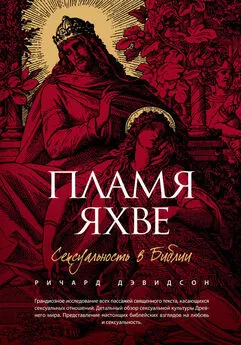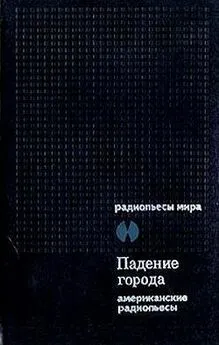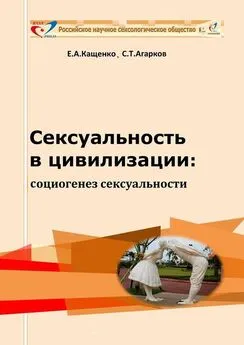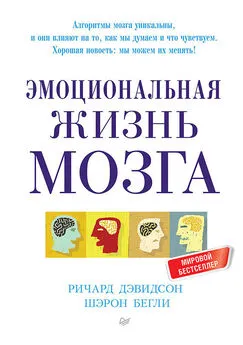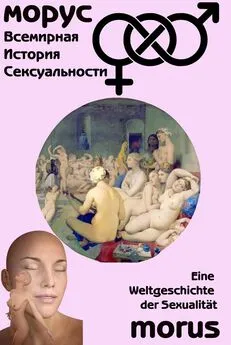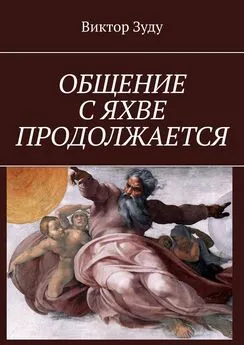Ричард Дэвидсон - Пламя Яхве. Сексуальность в Библии
- Название:Пламя Яхве. Сексуальность в Библии
- Автор:
- Жанр:
- Издательство:Литагент «5 редакция»fca24822-af13-11e1-aac2-5924aae99221
- Год:2015
- Город:Москва
- ISBN:978-5-699-69728-1
- Рейтинг:
- Избранное:Добавить в избранное
-
Отзывы:
-
Ваша оценка:
Ричард Дэвидсон - Пламя Яхве. Сексуальность в Библии краткое содержание
Эта книга – не имеющее аналогов всеобъемлющее исследование библейских представлений о человеческой сексуальности. Известный специалист по Библии рассмотрел каждый пассаж священного текста, касающийся сексуальных отношений, и представил общие контуры того, как понимали сексуальность в мире Библии и других древних культурах. Автор демонстрирует красоту и естественность библейских представлений о человеческой сексуальности на фоне грандиозной картины прелюбодеяния в Древнем мире во всех его проявлениях, подчас шокирующих.
Пламя Яхве. Сексуальность в Библии - читать онлайн бесплатно ознакомительный отрывок
Интервал:
Закладка:
804
См. особенно Rosemary Radford Ruether, Sexism and God-Talk: Toward a Feminist Theology (Boston: Beacon, 1983), 53–54; ср. Daly, Beyond God the Father , 19; Judith Ochshorn, The Female Experience and the Nature of the Divine (Bloomington: Indiana University Press, 1981), 194–195; Esther Fuchs, “The Literary Characterization of Mothers and Sexual Politics in the Hebrew Bible,” in Feminist Perspectives on Biblical Scholarship (ed. Adela Yarbro Collins; Chico, Calif.: Scholars Press, 1985), 119. Marsman, Women in Ugarit and Israel , рассматривает в том числе и это расхожее утверждение феминисток. В своей объемной (781 страница!) монографии она убедительно показывает, что социальный и религиозный статус женщин в монотеистическом Израиле отнюдь не был хуже, чем в соседнем Угарите и других соседних ближневосточных землях, где процветали многобожие и почитание богини.
805
Обзор статуса женщин на древнем Ближнем Востоке см. особенно в: Tetlow, The Ancient Near East , passim. Согласно Тетлоу, женщины имели почти равные права с мужчинами в древнейших цивилизациях Шумера и Ассирии староассирийского периода; в Старовавилонском царстве статус женщин был еще относительно высок, но в более поздних племенных, феодальных и военных обществах Ближнего Востока (хеттском, поздневавилонском, среднеассирийском, позднеассирийском) этот статус упал, причем самым низким был в среднеассирийском и позднеассирийском обществах. Ср. James R.Baker, Women’s Rights in Old Testament Times (Salt Lake City: Signature Books, 1992); Carol R.Fontaine, “A Heifer from Thy Stable: On Goddesses and the Status of Women in the Ancient Near East,” in “Ad feminam: Fiftieth Anniversary Volume,” ed. Alice Bach, USQR 43 (1989): 67–91; Hurley, Man and Woman , 21–30; Arthur Frederick Ide, Women in the Ancient Near East (Mesquite, Tex.: Ide House, 1982); Elizabeth Mary McDonald, The Position of Women as Reflected in Semitic Codes of Law (Toronto: University of Toronto Press, 1931); Patrick Mullins, “The Public, Secular Roles of Women in Biblical Times,” Mils 43 (1998): 79–111; idem, “The Religious Roles of Women among Israel’s Neighbors,” Mils 45 (2000): 81–113; Ilse Seibert, Women in the Ancient Near East (New York: Abner Schram, 1974). Beckman, “Goddess Worship,” 20, подытоживает ситуацию в хеттской религиозной культуре: «В сфере религиозной практики авторитет женщин был приблизительно равным мужскому». Что касается Месопотамии, сейчас ученые склонны думать, что права и статус женщин были выше (особенно в древнем Шумере), чем считалось раньше, хотя (особенно в ассирийском обществе) жена была гораздо больше подчинена мужу, чем в Израиле. См. Rivkah Harris, “Women (Mesopotamia),” ABD 6:947–951 (с библиографией); Sophie Lafont, Femmes, droit, et justice dans l’antiquité orientale: Contributions à l’étude du droit pénal au Proche-Orient ancien (OBO 165; Göttingen: Vandenhoeck&Ruprecht, 1999), passim; Sarah C.Melville, “Neo-Assyrian Royal Women and Male Identity: Status as a Social Tool,” JAOS 124 (2004): 37–57; Claudio Saporetti, The Status of Women in the Middle Assyrian Period (Monographs on the Ancient Near East 2/1; Malibu, Calif.: Undena, 1979); Tetlow, The Ancient Near East , passim. Относительно древнего Мари см. Bernard F.Batto, Studies on Women at Mari (Baltimore: Johns Hopkins University Press, 1974). Относительно Угарита см. Marsman, Women in Ugarit and Israel , passim. Относительно Египта см., например, Christiane Desroches-Noblecourt, La femme au temps des pharaons (Paris: Pernoud, 1986); Leonard H.Lesko, “Women and Priests in Two Egyptian Stories,” in Hesed Ve-Emet: Studies in Honor of Ernest S.Frerichs (ed. Jodi Magness&Seymour Gitin; BJS 320; Atlanta: Scholars Press, 1998), 217–229; Lise Manniche, Sexual Life in Ancient Egypt (London: Kegan Paul, 1987); Alan R.Millard, “The Position of Women in the Family and Society in Ancient Egypt with Special Reference to the Middle Kingdom” (PhD diss., University of London, University College, 176); Gay Robins, Women in Ancient Egypt (London: British Museum, 1993). Дальнейшую библиографию см. в: Gruber, Women in the Biblical World , 156–226.
806
Otwell, And Sarah Laughed , 193. Отуэлл – один из ведущих сторонников этой точки зрения. Однако он цитирует и других «диссидентов» (сс. 10–11, 195–196). Из более поздних работ см., например, Bronner, Stories of Biblical Mothers ; Thomas Finley, “The Relationship of Woman and Man in the Old Testament,” in Women and Men in Ministry: A Complementary Perspective (ed. Robert L.Saucy&Judith K.TenElshof; Chicago: Moody, 2001), 61–88; Daniel Friedmann, To Kill and Take Possession: Law, Morality, and Society in Biblical Stories (Peabody, Mass.: Hendrickson, 2002), 218–231; Gerhard F.Hasel, “Equality from the Start: Woman in the Creation Story,” Spectrum 7, no. 2 (1975): 26–27; Hurley, Man and Woman , 20–57; Walter C.Kaiser Jr., Toward Old Testament Ethics (Grand Rapids: Zondervan, 1983), 204–208; Faith McBurney Martin, Call Me Blessed: The Emerging Christian Woman (Grand Rapids: Eerdmans, 1988), 113–138; Meyers, Discovering Eve , passim; Amnon Shapira, “On the Equal Status of Women in the Bible” (иврит), Beit Mikra 159 (1999): 309–337 (см. краткий пересказ в: Christopher T. Begg, OTA 23 [2000]: 195–196); Savina J.Teubal, Sarah the Priestess: The First Matriarch of Genesis (Athens, Ohio: Swallow, 1984), особенно сс. 138–141. См. также авторов первой волны феминизма, которые считали статус женщин в ВЗ высоким: например, Starr, The Bible Status of Woman .
807
См. особенно Davidson, “Women in Scripture,” 161–167; idem, “Modern Feminism,” 415–412. Ср. обширную библиографию в: Bellis, Helpmates, Harlots, and Heroes , 95–98, 110–111.
808
См. особенно. Jo Ann Davidson, “Genesis Matriarchs Engage Feminism,” AUSS 40, no. 2 (2002): 169–178; idem, “The Well Women of Scripture Revisited,” JATS 17, no. 1 (2006): 209–220. См. краткую дискуссию/идентификацию каждой из этих 29 женщин в: Toni Craven, “Women in Genesis,” TBT 35 (1997): 32–39. Ср. Bronner, Stories of Biblical Mothers , 1–25; Irmtraud Fischer, Women Who Wrestled with God: Biblical Stories of Israel’s Beginnings (trans. Linda M.Maloney; Collegeville, Minn.: Liturgical, 2005), 1–112.
809
Teubal, Sarah the Priestess , xi.
810
См. интересные исследования о Сарре: Bellis, Helpmates, Harlots, and Heroes , 70–74; Mark E.Biddle, «The “Endangered Ancestress” and Blessing for the Nations,» JBL 109 (1990): 599–611; Adrien Janis Bledstein, “The Trials of Sarah,” Judaism 30 (1981): 411–417; Katheryn Pfisterer Darr, Far More Precious than Jewels: Perspectives on Biblical Women (Louisville: Westminster John Knox, 1991), 85–131; Dennis, Sarah Laughed , 34–61; J.Cheryl Exum, «Who’s Afraid of “the Endangered Ancestress”?» in The New Literary Criticism and the Hebrew Bible (ed. J.Cheryl Exum&David J.A.Clines; Sheffield, Eng.: JSOT Press, 1993), 91–113; Sharon Pace Jeansonne, The Women of Genesis: From Sarah to Potiphar’s Wife (SCB 4; Minneapolis: Fortress, 1990), 14–30; Jacques Nicole&Marie-Claire Nicole, “Sara, soeur et femme d’Abraham,” ZAW 112 (2000): 5–23; Janice Nunnally-Cox, Foremothers: Women of the Bible (New York: Seabury, 1981), 5–9; Sakenfeld, Just Wives? 7–25; Tammi J. Schneider, Sarah: Mother of Nations (New York: Continuum, 2004); idem, “Sarah: The Chosen Mother,” TBT 44 (2006): 76–80; Teubal, Sarah the Priestess ; Phyllis Trible, “Genesis 22: The Sacrifice of Sarah,” in Not in Heaven: Coherence and Complexity in Biblical Narrative (ed. Jason P.Rosenblatt&Joseph C.Sitterson; Bloomington: Indiana University Press, 1991), 170–191; Jack W.Vancil, “Sarah – Her Life and Legacy,” in Essays on Women in Earliest Christianity (ed. Carroll D.Osburn; 2 vols.; Joplin, Mo.: College Press, 1995), 2:37–68. О Сарре и Агари: Amy-Jill Levine, “Settling at Beer-lahai-roi,” in Daughters of Abraham: Feminist Thought in Judaism, Christianity, and Islam (ed. Yvonne Yazbeck Haddad&John L.Esposito; Gainesville, Fla: University Press of Florida, 2001), 12–34; Dora R.Mbuwaye-sango, “Childlessness and Woman-To-Woman Relationships in Genesis and African Patriarchal Society: Sarah and Hagar from a Zimbabwean Woman’s Perspective (Gen. 16:1–16; 21:8–21),” Semeia 78 (1997): 27–36; Phyllis Trible, “Ominous Beginnings for a Promise of Blessing,” in Hagar, Sarah, and Their Children: Jewish, Christian, and Muslim Perspectives (ed. Phyllis Trible&Letty M.Russell; Louisville, Ky.: Westminster John Knox, 2006), 33–69.
811
См. анализ в: Mary J.Evans, “The Invisibility of Women: An Investigation of a Possible Blind Spot for Biblical Commentators,” CBRFJ 122 (1990): 37–38.
812
Nunnally-Cox, Foremothers , 9.
813
Cynthia Gordon, “Hagar: A Throw-away Character among the Matriarchs?” SBL Seminar Papers, 1985 (SBLSP 24; Atlanta: Scholars Press, 198S), 271. Гордон пытается доказать, что Агарь не такова (сс. 271–277).
814
Ibid., 277. Помимо исследования Гордон см. особенно: Wilma Ann Bailey, «Black and Jewish Women Consider Hagar,” Enc 63 (2002): 37–44; idem, “Hagar: A Model for an Anabaptist Feminist?” MQR 68 (1994): 219–228; Alan Cooper, “Hagar in and out of Context,” USQR 55 (2001): 3S–46; Dennis, Sarah Laughed , 62–83; Philip R.Drey, “The Role of Hagar in Genesis 16,” AUSS 40 (2002): 179–195; Frymer-Kensky, Reading the Women of the Bible , 225–237; Jo Ann Hackett, “Rehabilitating Hagar: Fragments of an Epic Pattern,” in Gender and Difference in Ancient Israel (ed. Peggy L.Day; Minneapolis: Fortress, 1989), 12–27; Scott K.Nikaido, “Hagar and Ishmael as Literary Figures: An Intertextual Study,” VT 51, no. 2 (2001): 219–242; Pamela Tamarkin Reis, “Hagar Requited,” JSOT 87 (2000): 75–109; Nina Rulon-Miller, “Hagar: A Woman with an Attitude,” in The World of Genesis: Persons, Places, Perspectives (ed. Philip R.Davies&David J.A.Clines; JSOTSup 2S7; Sheffield, Eng.: Sheffield Academic Press, 1998), 60–89; Savina J.Teubal, Hagar the Egyptian: The Lost Tradition of the Matriarchs (San Francisco: Harper&Row, 1990); Phyllis Trible, “The Other Woman: A Literary and Theological Study of the Hagar Narratives,” in Understanding the Word: Essays in Honor of Bernhard W. Anderson (ed. James T.Butler, Edgar W.Conrad&Ben C.Ollenburger; JSOTSup 37; Sheffield, Eng.: JSOT Press, 198S), 221–246; idem, Texts of Terror: Literary-Feminist Readings of Biblical Narratives (Philadelphia: Fortress, 1984), 9–20; Renita J.Weems, Just a Sister Away: A Womanist Vision of Women’s Relationships in the Bible (San Diego: LuraMedia, 1988), 1–21; Richard D.Weis, “Stained Glass Window, Kaleidoscope, or Catalyst: The Implications of Difference in Readings of the Hagar and Sarah Stories,” in A Gift of God in Due Season: Essays on Scripture and Community in Honor of James A.Sanders (ed. Richard D.Weis&David M.Carr; JSOTSup 225; Sheffield, Eng.: Sheffield Academic Press, 1996), 253–273; Delores S.Williams, Sisters in the Wilderness: The Challenge of Womanist God-Talk (Maryknoll, N.Y.: Orbis Books, 1993), 1–33. (Некоторые из этих исследований, особенно Ралон-Миллер и Тойбал, хотя и содержат интересные мысли, существенно переиначивают или даже деконструируют библейскую картину.)
Читать дальшеИнтервал:
Закладка:
